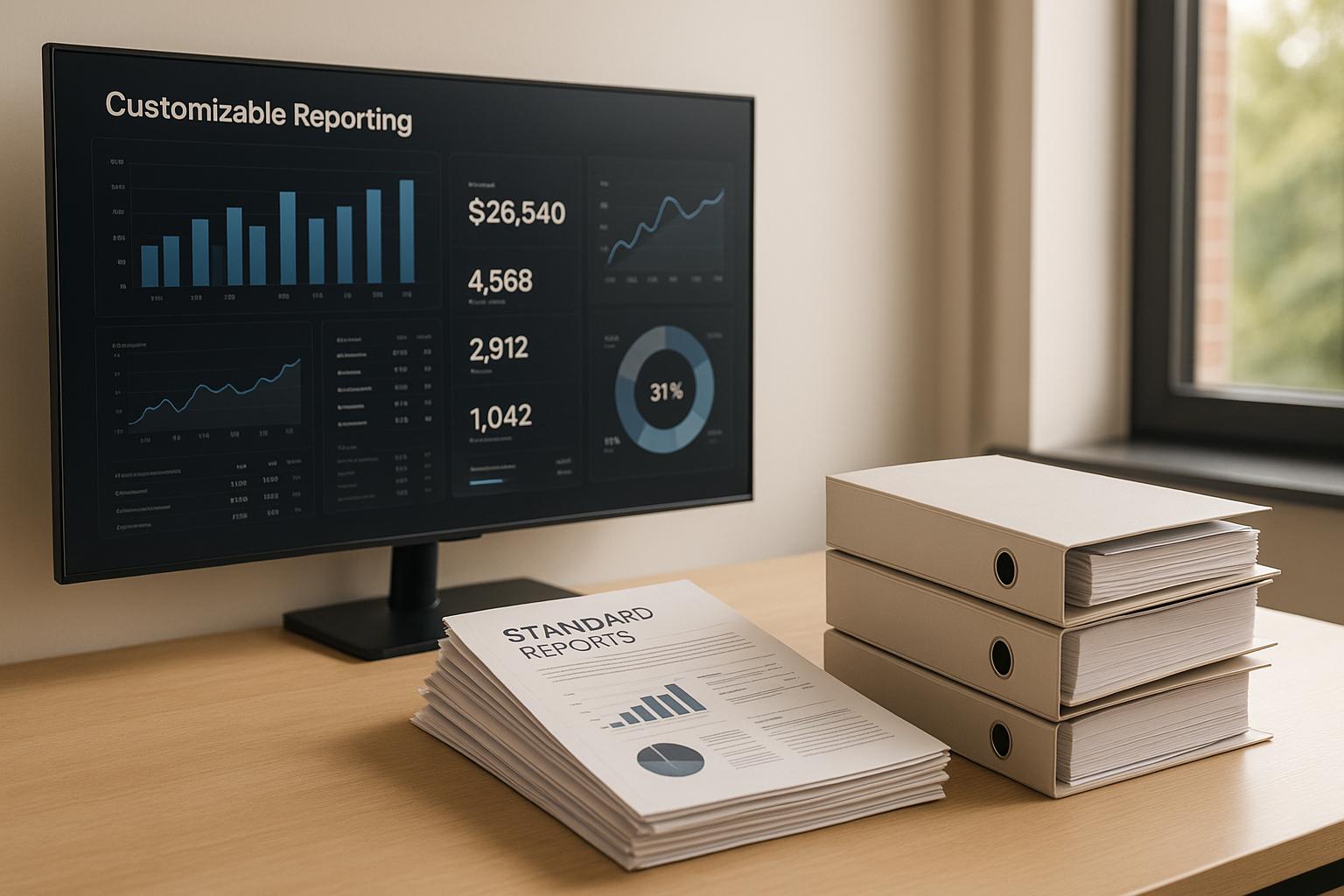Cash Flow Analytics for Liquidity Buffer Management

Managing liquidity is make-or-break for growth-stage companies. Here's why: unpredictable cash flows and limited financing options can derail operations. Over 60% of businesses face liquidity problems, and poor cash management is a leading cause of startup failure within five years.
The solution? Cash flow analytics combined with liquidity buffers. This approach helps businesses forecast cash needs, avoid financial surprises, and maintain flexibility during growth phases.
Key Takeaways:
- Liquidity Buffers: Reserves like cash or marketable securities to cover short-term needs.
- Cash Flow Analytics: Tools to predict inflows/outflows, identify gaps, and optimize reserves.
- Core Components: Accurate forecasting, receivables/payables analysis, and liquidity ratios.
- Technology: Real-time data, automation, and predictive analytics improve decision-making.
- Best Practices: Set buffer targets, update forecasts frequently, and seek expert financial guidance.
Growth-stage companies can stay resilient by combining data-driven tools with sound financial strategies. Let’s dive deeper into how this works.
Key Components of Cash Flow Analytics for Liquidity Management
Managing liquidity effectively relies on three core components: cash flow forecasting, receivables/payables analysis, and liquidity ratios. Together, they provide a clear picture of your company's financial flexibility.
Cash Flow Forecasting
Cash flow forecasting helps estimate the movement of cash over specific timeframes. This allows businesses to plan ahead, meet financial obligations, and avoid cash shortages.
For growing companies, a 13-week forecast is commonly used to ensure short-term accuracy while also supporting strategic long-term planning. There are two main approaches to forecasting:
- Direct Method: Tracks actual inflows and outflows, making it ideal for businesses with fluctuating revenue streams.
- Indirect Method: Starts with net income and adjusts for non-cash transactions, better suited for companies with stable earnings.
For instance, Cenveo improved its cash forecast accuracy by 93% using Kyriba's Liquidity Performance Platform. Similarly, Varsity Brands achieved over 90% accuracy by adopting Kyriba's advanced tools. Research from Aberdeen and IBM further highlights that rolling forecasts can enhance revenue accuracy by about 14%.
"In today's fast-paced financial environment, accurate cash forecasting serves as a blueprint for organizations aiming to maximize liquidity performance, reduce risk, and make strategic decisions with confidence." - Kyriba
AI-driven automation simplifies data collection, enabling predictive analytics and anomaly detection. This approach prioritizes actionable insights, helping businesses focus on practical outcomes rather than perfect precision.
Once forecasting is in place, the next step is analyzing receivables and payables to better align cash inflows and outflows.
Analyzing Accounts Receivable and Payable
Understanding how money flows in and out of your business is essential for maintaining steady cash flow and setting appropriate liquidity reserves. For growing companies, late customer payments can cause significant disruptions.
Analyzing accounts receivable helps identify payment trends and spot potential cash flow issues. Companies relying on a single client for more than 30% of their revenue are especially vulnerable. According to CB Insights, nearly 38% of startups fail because they run out of cash - often due to poor receivables management.
For example, an architecture firm’s six-month forecast revealed cash deficits in the early months, emphasizing the importance of having sufficient reserves.
On the payables side, negotiating longer payment terms with suppliers can help conserve cash, especially during slower periods. Seasonal businesses, in particular, benefit from aligning payments with off-peak times to smooth out fluctuations.
By managing both receivables and payables effectively, businesses can improve cash flow predictability. Strategies like setting clear payment terms, requiring deposits for large projects, and diversifying the client base can further reduce risks.
Finally, assessing liquidity ratios provides a quantitative measure of financial health.
Liquidity Ratios and Financial Health
Liquidity ratios offer a snapshot of a company’s ability to meet short-term obligations and help benchmark financial performance.
Here are three key liquidity ratios:
| Liquidity Ratio | Formula | Purpose |
|---|---|---|
| Current Ratio | Current Assets / Current Liabilities | Measures the ability to cover short-term liabilities with total current assets |
| Quick Ratio | (Cash + Marketable Securities + Accounts Receivable) / Current Liabilities | Evaluates the ability to meet obligations using the most liquid assets, excluding inventory |
| Cash Ratio | (Cash + Short-Term Investments) / Current Liabilities | Focuses on covering short-term debt using only cash and cash equivalents |
For startups, maintaining a ratio between 1.5 and 2 is often ideal. This range provides a safety net without locking up too much capital. While a ratio above 1 indicates sufficient assets to cover liabilities, the exact target depends on the company’s stage and industry.
"Liquidity ratios provide insights into your company's short-term cash flow and ability to meet immediate obligations." - Brad Einstein, Staff Writer, Harvard Business School Online
Each ratio offers a unique perspective: the current ratio gives a broad view, the cash ratio takes a conservative approach, and the quick ratio balances the two by excluding inventory. Monitoring all three ensures a well-rounded understanding of financial health.
Regularly tracking these ratios can highlight potential issues early, allowing for timely adjustments. Comparing current metrics against historical data or industry standards can help determine whether liquidity buffers need to be recalibrated. This ensures businesses are ready to seize growth opportunities while staying prepared for unexpected challenges.
Technology and Data-Driven Approaches
Modern technology is transforming how growth-stage companies manage their liquidity buffers by offering real-time insights and predictive capabilities. Instead of relying on outdated monthly reports, businesses can now monitor cash positions continuously, using up-to-date data to make smarter decisions.
Real-Time Data Synchronization
Access to real-time financial data allows finance teams to stay on top of their cash flow, execute transactions efficiently, and optimize cash positions. This kind of immediate visibility not only highlights potential liquidity risks but also enables early interventions to avoid cash shortfalls.
For example, banks using API-connected Treasury Management Systems (TMS) with real-time balance visibility report 22–30% less idle liquidity compared to those relying on batch-driven systems. This reduction in idle cash translates to better capital allocation and higher returns on available funds.
"Many treasurers are thinking, 'Well, how can I extract that last ounce of juice from my financial ecosystem?'" - Ambrish Bansal, global head of liquidity and cash concentration products for the Citi Treasury and Trade Solutions business
The Clearing House's RTP® instant payments network is a game-changer, with 285,000 businesses utilizing it monthly. Meanwhile, nearly one-third of small and medium businesses are shifting to instant payments, leaving traditional checks behind.
For growth-stage companies, real-time synchronization offers transparency with immediate transaction confirmations, faster reconciliation, and a clear view of liquidity positions. Cloud-based platforms enhance this by providing scalability, seamless system integration, and support for open banking and APIs.
Advanced Analytics and Tools
Advanced analytics tools are reshaping liquidity planning by identifying cash flow trends and improving forecasting accuracy. These tools go beyond simple reporting, delivering actionable insights that help businesses make strategic decisions.
Considering that 82% of businesses fail due to cash flow mismanagement, adopting effective analytics is crucial. The best liquidity management software includes features like real-time visibility, forecasting, scenario modeling, automation, risk management, and multi-currency support.
Scenario planning is especially valuable for growth-stage companies. Peter Welch, CFO at Heartland, shared:
"We used Centage to do some worst-case scenario planning, such as losing 50% of our revenue and planned hours. It was a huge benefit to forecast the impact on our revenue."
AI and machine learning are playing a growing role in recognizing patterns, helping companies spot seasonal trends, payment behaviors, and market shifts that impact cash flow. When selecting analytics tools, look for customizable dashboards, seamless integration with accounting or ERP systems, and automated processes. By automating routine tasks, finance teams can focus on strategic analysis rather than data collection.
Weekly accounting systems take these insights further by offering near-real-time cash flow updates, helping refine liquidity management even more.
Weekly Accounting Systems and Financial Models
Weekly accounting systems, powered by technology, provide the visibility and flexibility needed for effective liquidity planning. These systems deliver frequent updates that allow businesses to track cash flow closely and adapt quickly to changes.
In today’s volatile economy, rapid shifts in costs, inventory, pricing, and customer demand can significantly impact revenue, margins, and cash flow. A recent survey found that 62% of CFOs and finance professionals view real-time financial data as essential for maintaining resilience, highlighting the shortcomings of traditional monthly reporting.
The 13-week cash flow model is a practical tool for short-term forecasting. It projects weekly cash inflows, outflows, ending cash, and available liquidity. By updating forecasts with actual cash flow data, finance teams can spot discrepancies, improve accuracy, and make better-informed adjustments.
Weekly accounting systems also allow businesses to incorporate variances into updated forecasts quickly. For instance, Phoenix Strategy Group's Weekly Accounting System provides real-time data synchronization and an integrated financial model through its Monday Morning Metrics. This ensures leadership teams start each week with the latest financial insights, enabling swift course corrections. It’s a clear example of how integrated, real-time solutions empower growth-stage companies to manage their liquidity buffers effectively.
Case Studies and Comparative Analysis
Real-world examples reveal how growth-stage companies are reshaping liquidity management through cash flow analytics, showcasing both challenges and measurable results.
Case Study: Liquidity Buffer Practices in Growth-Stage Companies
Manufacturing: Managing Cyclical Demand
A mid-sized industrial equipment manufacturer faced challenges with fluctuating working capital due to cyclical demand. Unpredictable cash flow swings made it tough to maintain sufficient liquidity buffers without tying up too much capital.
By leveraging predictive analytics and advanced demand forecasting, the company achieved a 95% accuracy in their 12-month cash flow forecast. This allowed for strategic decisions in inventory management, supplier negotiations, and financing schedules.
The outcomes were impressive: inventory carrying costs dropped by 18%, borrowing costs fell by 12%, and production efficiency improved through better staffing alignment. These changes led to a 22% boost in cash flow efficiency and a 15% rise in EBITDA over two years, as detailed in the 2022 Industry Week Case Study.
SaaS: Optimizing Subscription Revenue
A growth-stage SaaS company serves as a prime example of how subscription-based businesses can fine-tune liquidity by analyzing customer acquisition costs, churn rates, and growth investments.
They implemented a data-driven forecasting system that modeled these variables across customer segments, uncovering cash flow trends that traditional accounting methods missed.
Post-implementation, the company reduced revenue forecast variance by 30%, enabling better liquidity buffer management. They identified high-value customer segments, flagged early churn risks, and optimized cash allocation between growth initiatives and reserves. These efforts fueled revenue growth from 18% to 27% year-over-year, as reported in the 2023 Forrester Research Case Study.
Retail: Tackling Seasonal Cash Flow Challenges
A multi-location retail chain addressed seasonal liquidity issues by using predictive analytics to smooth working capital fluctuations without holding excessive cash reserves.
Their system integrated data from weather forecasts, social media sentiment, local economic trends, and competitor promotions. This provided a clear view of seasonal cash flow patterns.
The results included a 24% reduction in inventory carrying costs, 15% better stock availability, improved renovation timing, and optimized staffing. These efforts contributed to a 9% increase in profit margins, as noted in the 2023 National Retail Federation Report.
Comparing Liquidity Buffer Strategies
These case studies highlight different approaches to managing liquidity buffers in growth-stage companies, each with unique benefits and challenges.
| Strategy | Pros | Cons | Adaptability | Effectiveness |
|---|---|---|---|---|
| Cash Reserves | Immediate access, high liquidity, security during uncertainty | Low returns, inflation risk, missed investment opportunities | Very High | Moderate |
| Short-Term Investments | Better returns than cash, relatively liquid | Market risks, transaction costs, potential value loss | High | Moderate to High |
| Lines of Credit | Flexible funding, reduces need for large reserves | Interest costs, limited availability during downturns, fees | Moderate | High |
| Factoring Receivables | Quick cash access, supports working capital needs | High fees, potential impact on customer relationships | Low | High (for short-term needs) |
The right strategy depends on a company’s growth stage, industry, and risk tolerance. Cash reserves are ideal for volatile industries or uncertain conditions, offering security at the expense of returns. Short-term investments strike a balance by providing better returns while retaining liquidity.
Lines of credit are particularly useful for growth-stage companies, offering flexibility without requiring large cash holdings. However, they may become less reliable during economic downturns. Factoring receivables, while effective for immediate cash needs, comes with higher costs, making it better suited as a backup strategy.
The most resilient companies often use a diversified approach, combining cash reserves for stability, lines of credit for flexibility, and short-term investments for excess funds. This strategy balances security with growth potential, allowing businesses to adjust liquidity management as conditions evolve.
Companies that employ advanced risk prediction tools experience 20-25% less cash flow volatility compared to their peers. This reduced volatility enables more precise liquidity buffer sizing and smarter capital allocation, underscoring the value of sophisticated analytics in managing financial stability.
sbb-itb-e766981
Best Practices for Liquidity Buffer Optimization
Getting liquidity buffer optimization right can give growth-stage companies a real advantage. It’s all about striking the perfect balance between financial stability and using capital efficiently.
Setting Target Buffer Levels
Figuring out the right buffer size isn’t as simple as following a rule of thumb - it demands a data-driven approach. While many companies stick to the common benchmark of maintaining 10–15% of annual cash outflows, the most successful ones dig deeper. They analyze their unique cash flow patterns to set more precise targets.
Start by examining your historical cash flow data. Look for seasonal trends, payment cycles, and any unexpected fluctuations that might impact your liquidity needs.
"Liquidity management is the foundation of a company's financial health. Without a clear understanding of where your cash is, even the most profitable businesses can struggle with day-to-day operations." - Jouni Kirjola, Head of Solutions & Presales, Nomentia
To size your buffer effectively, create multiple forecast scenarios. Build projections for 3–6 months, 6–12 months, and 12–18 months, factoring in growth plans, market changes, and potential disruptions. This layered approach ensures your buffer can adapt as conditions shift.
Key performance indicators (KPIs) are also critical for optimizing liquidity buffers. Metrics like Days Sales Outstanding (DSO), Days Payable Outstanding (DPO), and the Cash Conversion Cycle (CCC) reveal working capital dynamics, helping you fine-tune your buffer levels.
| KPI | Formula | Target Range |
|---|---|---|
| DSO | Accounts Receivable ÷ Revenue × 365 | 30–45 days |
| DPO | Accounts Payable ÷ COGS × 365 | 45–60 days |
| CCC | DSO + Inventory Days − DPO | 30–60 days |
Companies that keep healthy liquidity buffers are 50% less likely to cut back on R&D during tough times, proving how strategic buffer management can safeguard long-term growth.
Once your buffer targets are set, regular updates to your forecasts are essential to keep up with changing conditions.
Regular Forecast Updates
Static forecasts don’t cut it in today’s fast-moving financial environment. You need to update them frequently - monthly during stable periods and weekly when things get volatile. Companies using rolling forecasts with regular updates often achieve forecasting accuracy that’s about 14% better than static annual budgets.
Interestingly, only 28% of companies manage to keep their cash forecasts within 10% of their annual free cash flow targets. This highlights how crucial it is to continuously refine your projections. To do this effectively, compare actual performance against forecasts and use the insights to improve future predictions.
"It's crucial for businesses to move beyond just manual data entry and spreadsheets. Automating cash flow tracking and forecasting is key to keeping pace with the complexities of today's financial landscape." - Karl-Henrik Sundberg, Product Manager, Cash Forecasting, Nomentia
By regularly updating forecasts, companies can maintain their optimized buffer levels and respond quickly to shifting circumstances.
Using Expert Financial Support
For growing companies, managing liquidity effectively often requires more expertise than they have in-house. Accurate forecasts are just the starting point - expert oversight ensures those forecasts are turned into actionable strategies.
This is where services like Phoenix Strategy Group’s fractional CFO and financial advisory offerings come in. These experts help businesses build reliable cash forecasting models and implement advanced liquidity management systems. Their experience and analytics tools can save companies the time and expense of developing these capabilities internally.
Expert financial support doesn’t stop at bookkeeping. It includes identifying inefficiencies, speeding up collections, and aligning expenses with revenue to improve cash flow. For example, Varsity Brands achieved over 90% forecasting accuracy by integrating expert-backed cash management systems.
Conclusion: Key Takeaways for Growth-Stage Companies
For growth-stage businesses, cash flow analytics isn't just a tool - it's the foundation for staying resilient and seizing opportunities.
By leveraging analytics to manage liquidity buffers, companies can navigate downturns, fuel expansion, optimize working capital, and mitigate financial volatility. It's worth noting that poor cash management remains one of the top reasons startups fail within their first five years.
"Cash is, and always has been, more than just king, it's the heartbeat of every growing business." – Gaviti.com
Technology has revolutionized how businesses approach liquidity management. Tools like real-time data synchronization, automated forecasting, and advanced analytics have become indispensable for maintaining financial health. These innovations emphasize the importance of adopting dynamic, tech-driven liquidity strategies.
As we've explored, regularly reviewing and adjusting liquidity buffers is critical for sustainable growth. Companies should use data to set precise target levels based on their cash flow patterns, update forecasts frequently, and seek expert financial advice when necessary. This is especially vital considering that 54% of CFOs identify liquidity management as their biggest challenge[2].
To stay ahead, growth-stage companies must combine advanced analytics with professional financial guidance. Phoenix Strategy Group offers fractional CFO and financial advisory services that help businesses build these capabilities in a cost-effective way. With the right approach, cash flow analytics can evolve from a compliance task into a powerful competitive edge.
FAQs
How does cash flow analytics support growth-stage companies in managing liquidity effectively?
Cash flow analytics gives growing companies a powerful way to keep their finances on track. By providing a clear view of where money is coming from and where it's going, businesses can better prepare for potential cash shortages or surpluses and take action to stay financially stable.
With the help of cash flow analytics, companies can predict future cash needs more accurately, make smarter decisions about their reserves, and ensure they have enough liquidity to cover both day-to-day operations and unexpected costs. This approach allows businesses to continue expanding while reducing financial risks.
How do real-time data and predictive analytics improve cash flow forecasting?
How Real-Time Data and Predictive Analytics Improve Cash Flow Forecasting
Real-time data and predictive analytics are reshaping how businesses approach cash flow forecasting, making the process more precise and actionable. With access to real-time data, companies can keep a constant eye on their cash flow, reducing manual errors and identifying potential liquidity issues before they escalate. This provides timely insights and enhances financial control.
Predictive analytics builds on this by using both historical and current data to project future cash flows. This empowers businesses to plan more effectively, manage risks, and make smarter strategic moves. Together, these tools help businesses fine-tune their liquidity reserves, navigate uncertainty with confidence, and stay ready to seize opportunities or tackle challenges as they arise.
Why should growth-stage companies regularly update their cash flow forecasts and liquidity buffers?
Keeping cash flow forecasts and liquidity reserves up-to-date is crucial for growth-stage companies. This practice helps avoid running out of cash, manage day-to-day expenses, and adapt to an ever-changing market landscape. Accurate forecasting shines a light on potential financial shortfalls early, ensuring businesses have enough liquidity to fuel growth efforts and handle surprises along the way.
By taking a proactive approach to cash flow analysis, companies can strengthen their ability to expand, minimize financial risks, and set themselves up for lasting success during these pivotal growth stages.




